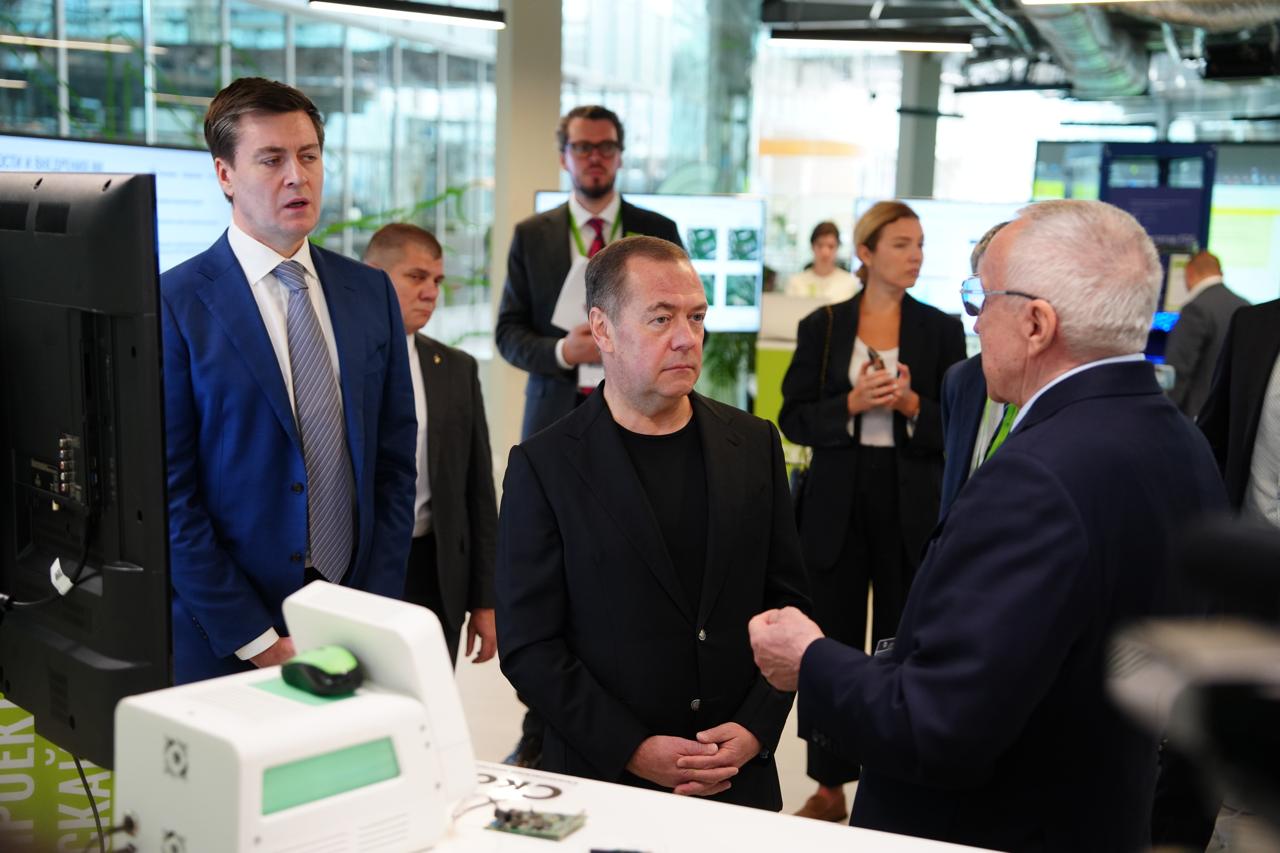More than 700 participants — representatives of the state, business, and science — gathered at the event in the Skolkovo Technopark to learn how to improve company processes using artificial intelligence, how to find applications for their developments, learn about market needs, and stay up to date with the latest developments. Among the honored guests of the event was Dmitry Medvedev, Deputy Chairman of the Security Council of the Russian Federation and Chairman of the Skolkovo Foundation Board of Trustees.
The team from the Skoltech AI Center, as well as the Bio and Photonics centers, led by the Institute’s President Alexander Kuleshov, presented seven of their own developments:
- Forecasting ice conditions in the Arctic using AI — a system for forecasting weather, oceanic, and ice conditions in the Arctic along the Northern Sea Route. The solution allows for creating daily 72-hour forecasts for the entire Northern Sea Route. The forecast resolution is 3-4 km for oceanic and ice conditions and 6 km for weather. In the near future, this service will be launched in open access for all interested parties, while subscription will provide access to operational forecasts.
- Software for enhancing the resolution of satellite images and recognizing target objects — AI-based solutions for creating a geoinformation system that enables analytics of satellite data from domestic spacecraft. Image detail is enhanced using generative AI. The algorithm is trained to restore higher-resolution images from lower spatial resolution images, with clearer object boundaries and better distinguishability. The tool can increase image resolution by four times. The solution has been licensed and is implemented by the Sputniks group of companies.
- Forecasting the probability of wildfires — a system based on AI algorithms allows for predicting the probability of fire occurrence using multimodal data from various sources — Earth remote sensing observations, meteorological data, terrain data, and population density data. The service automatically provides a daily five-day forecast for all regions of the Russian Federation. The solution is currently undergoing operational use within the framework of the Ministry of Emergency Situations under a special license.
- Identifying the source of atmospheric emissions — a product that allows for detecting the source of emissions based on readings from air quality monitoring stations. The intended use of the product is the rapid response to emissions and taking measures to eliminate them by monitoring and control bodies of enterprise emissions, as well as environmental services. The product is based on reverse modeling of particle dispersion in the atmosphere along a simulated wind field. The developed approach can be scaled to identify the source of radioactive emissions and for the optimal placement of sensors around an enterprise or city.
- Detecting AI-generated texts by internal language structure — a multilingual detector distinguishes human texts from AI texts by analyzing stable properties of their representations within a special neural network. Texts written by humans and AI have different “pattern complexity” — the so-called intrinsic dimension: It is consistently higher for human texts and lower for generated ones. This property is universal and works for different languages, styles, models, and is resistant to text rewriting. Among the application areas of the solution are checking student papers, verifying materials and comments in the media, protection against covert AI-generated information injections, identifying synthetic content in appeals and public discussions in the public sector, and controlling the origin of texts in competitions, grants, and in the field of copyright.
- “Aging Clock” — an application for assessing biological age. This generalized indicator of the body’s condition may differ from chronological age — it reflects the rate of individual aging. Algorithms have been developed to assess biological age, allowing for the quantitative assessment of the level of age-related changes in a particular person’s body based on various primary biomarkers — from simple clinical indicators (e.g., blood biochemistry) to epigenetic information, including DNA methylation. The application is currently used in the clinical practice of the Russian Gerontological Research and Clinical Center.
- E-nose — a development that mimics the work of biological olfaction. The technology is based on an array of 17 cross-sensitive sensors on a miniature silicon chip. The device can be trained for various tasks: analyzing the quality of food materials and plastics, detecting hazardous and explosive substances, including elusive components, and so on. The application of the electronic nose can improve security systems at major events, production facilities, transport hubs, and other sites. The research group is simultaneously developing materials, electronics, and analysis algorithms — this is a unique set of competencies in Russia for this scientific field.
Artificial intelligence is one of the key research areas at Skoltech, which has become a cross-cutting theme of the institute. It is already impossible to imagine modern research in any field without the implementation of AI technologies, including energy, transport, medicine, and many others.
The Institute’s Artificial Intelligence Center brings together over 300 researchers, engineers, and graduate students. The center's mission is to develop platform solutions for industry, energy, transport, and sustainable development using advanced AI methods (generative models, 3D computer vision, predictive analytics and signal processing, etc.). In terms of the number of papers at A* conferences, Skoltech is the leader in Russia among educational institutions, and the developed algorithms are already used by market-leading companies. Within the educational track, the center's specialists oversee master's and PhD programs, as well as additional professional education courses in AI and robotics, and the international Summer Machine Learning School (SMILES). Five professors from the center are in the top 2% of the most highly cited scientists in their fields, according to Stanford University and Elsevier.

